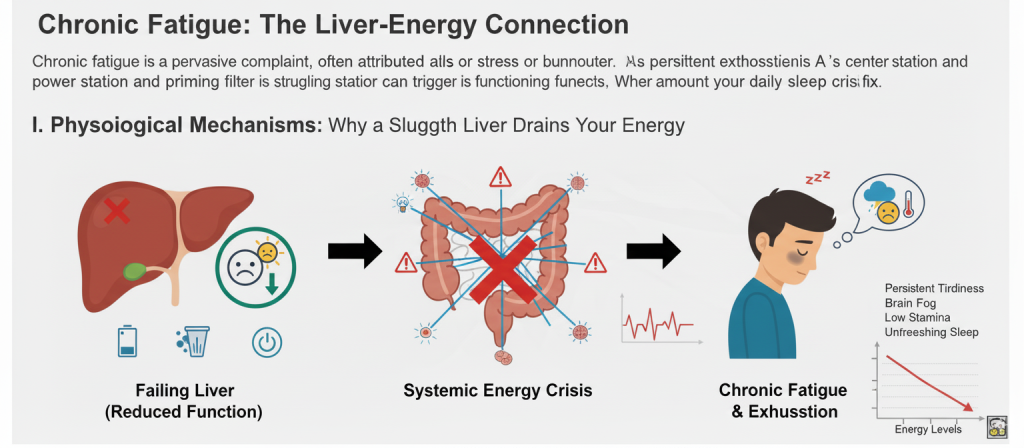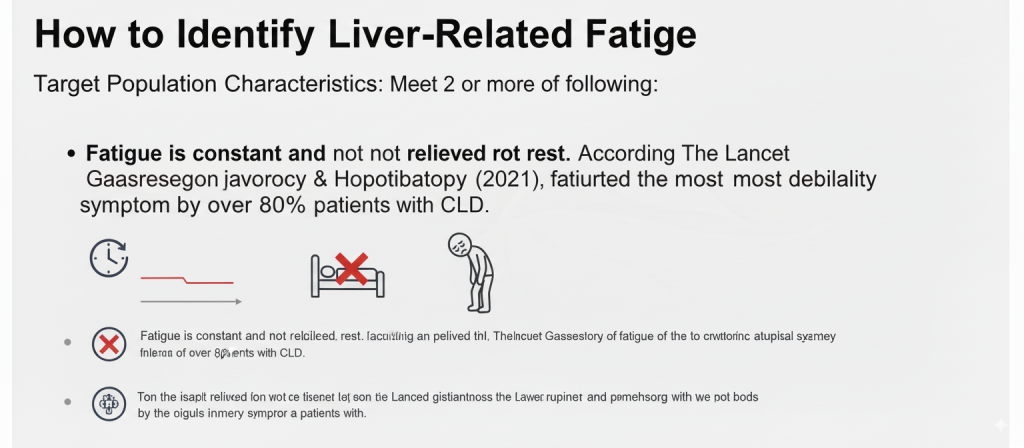Introduction
Chronic fatigue is a pervasive complaint, often attributed to stress or burnout. However, one of the most overlooked causes of persistent exhaustion is a struggling liver. As the body’s central power station and primary filter, the liver’s health is directly tied to your daily energy. When its function declines, it can trigger a systemic energy crisis that no amount of sleep can fix.
I. Physiological Mechanisms: Why a Sluggish Liver Drains Your Energy

Disrupted Energy Metabolism and Glycogen Storage
The liver acts as the body’s “glucose battery,” storing and releasing glucose to maintain stable energy. In liver disease, this function is impaired. Research in the Journal of Clinical Investigation (2019) shows that impaired hepatic glycogenesis can lead to a 40% reduction in energy stability after meals, causing frequent energy crashes and profound fatigue.
Accumulation of Fatigue-Inducing Toxins
When the liver is overwhelmed, metabolic byproducts like ammonia accumulate. While high levels of ammonia cause cognitive issues, a key review in Gastroenterology (2017) identifies that one of its earliest symptoms is severe lethargy. This toxic buildup directly suppresses central nervous system activity, making you feel perpetually drained.
Mitochondrial Dysfunction and Oxidative Stress
Chronic Liver Disease (CLD) generates massive oxidative stress, which damages mitochondria—the “powerhouses” inside our cells. A study in Free Radical Biology and Medicine (2019) explains that this systemic mitochondrial damage cripples the body’s ability to produce ATP (cellular energy), with some studies showing a 30-50% decrease in ATP synthesis capacity in CLD patients, resulting in deep, persistent fatigue.

How to Identify Liver-Related Fatigue
Target Population Characteristics: Meet 2 or more of the following:
Fatigue is constant and not relieved by rest. According to The Lancet Gastroenterology & Hepatology (2021), fatigue is reported as the most debilitating symptom by over 80% of patients with CLD.
Feeling particularly sluggish or sleepy after consuming high-fat meals.
Co-existing conditions like obesity, metabolic syndrome, or insulin resistance.
Accompanied by other signs of liver strain: digestive issues, skin problems, or “spider veins.”
Diagnostic Methods & Supporting Data:
Liver Enzyme Panel (ALT, AST, GGT): To detect inflammation or damage.
Complete Blood Count (CBC): To rule out anemia, another common cause of fatigue.
Assessment for Insulin Resistance: Checking fasting glucose and insulin.
Strategies for Boosting Liver Health and Energy:
Revitalizing your energy starts with supporting your liver through a diet low in inflammatory fats and sugar, and rich in antioxidants.
For a more advanced strategy, natural compounds that target both liver protection and cellular energy are effective. The combination of Artichoke Extract and Milk Thistle provides comprehensive support. Artichoke extract stimulates bile production, improving fat digestion and reducing the metabolic load on the liver, while Milk Thistle protects liver cells from the oxidative stress that drains energy.
The BISPIT Hepato-Protect Complex leverages this synergy. By enhancing the liver’s detoxification capabilities and protecting its cellular machinery, the formula helps restore metabolic efficiency. This dual approach addresses the root causes of liver-related fatigue by lightening the toxic burden and repairing the mitochondrial function essential for energy production.
Data Sources:
Journal of Clinical Investigation 2019;129(11):4773-4788
Gastroenterology 2017;153(6):1570-1585
Free Radical Biology and Medicine 2019;133:148-160
The Lancet Gastroenterology & Hepatology 2021;6(9):738-749
